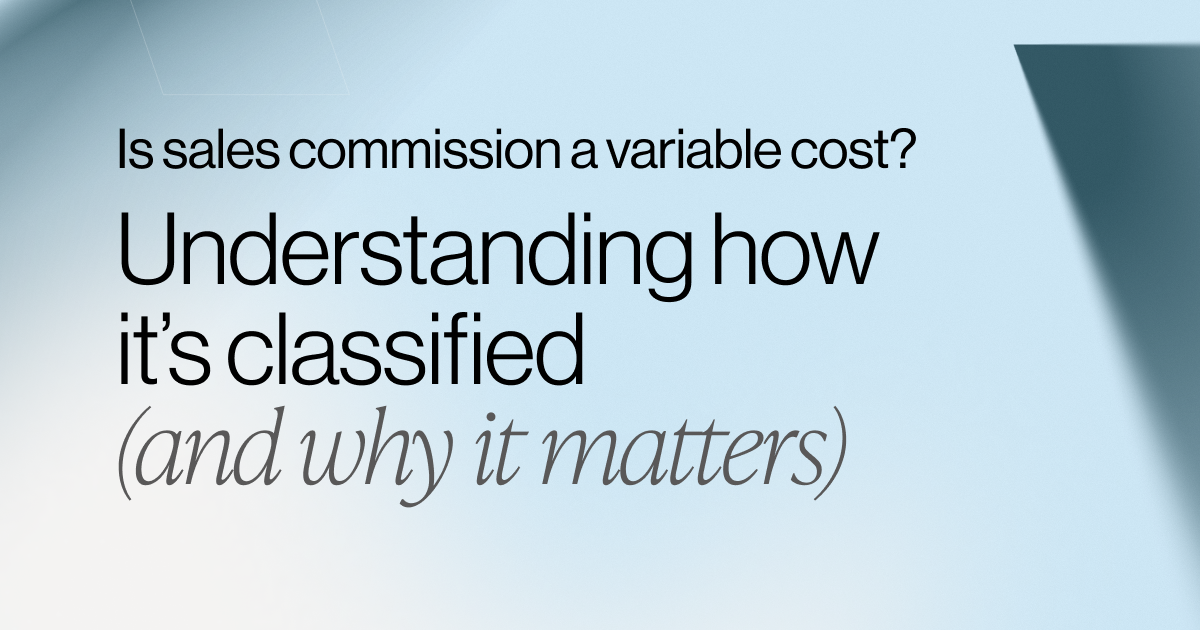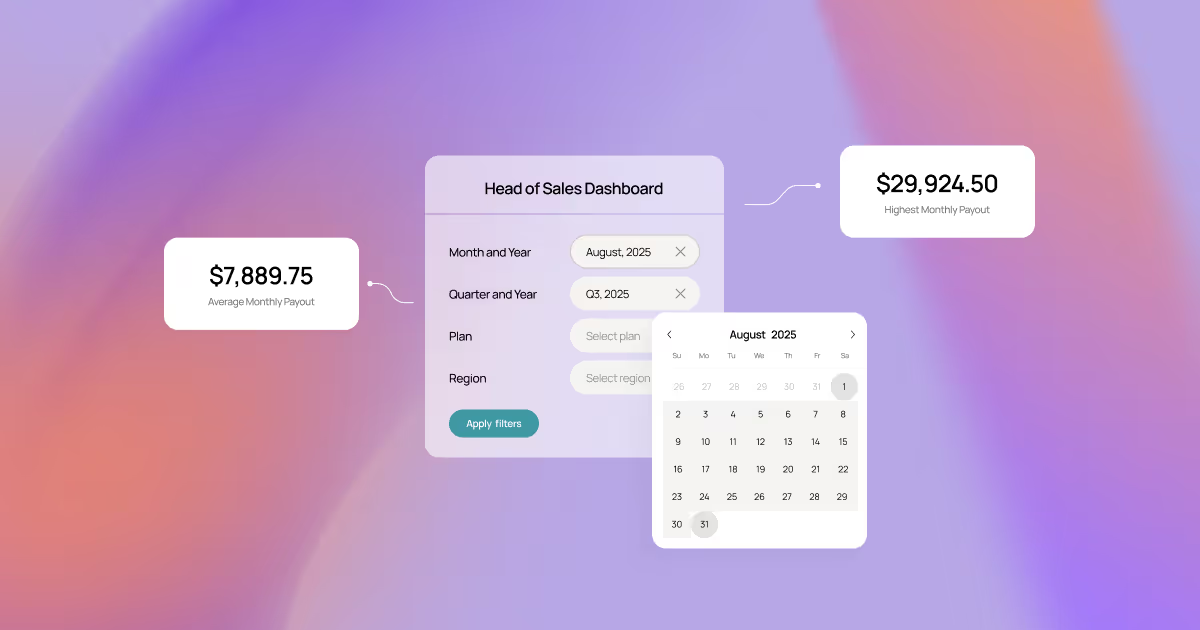7 Common Commission Management Mistakes and How to Avoid Them
When executed correctly, nothing is more motivating to a sales team than a fair and clearly-defined commission structure.
On the other hand, nothing is more disheartening to sellers than commission payout mistakes. Even one mistake to a rep’s payout can cause a domino effect that tanks performance and causes top talent to run for the hills.
Here’s a look at the seven most common mistakes made when managing commissions, so you can better protect yourself from a commission disaster.
1. Using a Generalized Commission Structure That Doesn’t Serve Your Business Needs
Building a commission structure from scratch can take significant time and effort. Making sure that it’s specifically tailored to the needs of both your sales team and your organization is tedious and time-consuming.

But trying to cut corners and save time by shoehorning someone else’s cookie-cutter commission structure into your sales organization is not a recipe for success. Implementing a sales commission structure that isn’t purpose-built just for you is likely to backfire and end up costing you more time and energy than building your own.
Take the time upfront to develop a commission structure that truly fits your sales team and you’ll save serious time and effort down the road. You can start with one of the common sales commission structures, decide which commission structure works for you, and adjust the finer details to fit your unique business needs.
2. Failing to Adjust Your Sales Commission Plan as Your Business Grows
Another common mistake that sales operations and finance leaders make is failing to evolve commission plans over time. Even if it might be tempting to take the “if it’s not broken, don’t fix it” approach to sales compensation, there are major benefits to consistently growing your commission plan as your business expands.
According to the 2022 Sales Compensation Trends Survey conducted by The Alexander Group, 43.5% of the 155 sales departments surveyed said they will make changes to performance measures in 2022. Only 14.4% will not make any changes to their sales compensation plan this year.
Considering that The Alexander Group is predicting revenue growth of 8% and a 3% increase in payouts over the next year, failing to keep pace with the market is bad for business. It will leave your salespeople feeling stagnant and looking for a sales team with a more dynamic commission plan.
If your salespeople are executing, your business will grow and change over time. Make sure that your commission structure does too. Evaluate comp plan effectiveness often and adjust commission as needed.
3. Promising Inflated Potential Earnings and Unrealistic OTEs
Sales organizations, especially in a hot job market, can sometimes be tempted to exaggerate potential earnings in order to attract top talent. Other times, it’s a top-down quota setting approach that leads to on-target earnings (OTE) numbers that are wildly unrealistic. Whatever the cause, advertising an OTE that isn’t reasonably achievable for 60-70% of sales representatives is a killer mistake.
Here’s why. When your top sales talent finds out that your advertised OTE numbers are unrealistic and unattainable, they’re likely to feel misled and become resentful. Wouldn’t you? Demoralized and disenchanted, it won’t be long before they start looking for a sales organization with a more realistic and transparent commission plan that gives them an honest shot at hitting the advertised expected earnings numbers.
4. Delivering Total Compensation Rates That Fall Below Market Rate
It’s also critical to make sure that your compensation plan, however it’s structured, can deliver earnings that don’t fall below the market average for comparable roles in the industry.
Whether it’s offering a base salary that’s too low given the opportunity for commission or a low commission rate alongside a base salary that’s too comfortable, implementing a plan that doesn’t adequately incentivize and reward your sales team is a huge mistake. It’s demotivating for your sellers and will leave you scrambling to fight either high attrition or low production.
Sales talent today can use resources like PayScale, Glassdoor, and RepVue to easily see what their value in the market is. If you fail to match what they can find elsewhere, you put yourself at a major disadvantage when trying to attract and retain strong sellers.
In fact, SaaStr founder Jason Lemkin recommends that “if you’re underpaying your sales reps, you need to course-correct within a quarter.” Otherwise, it’s already too late.
Regardless of the sales compensation structure that best suits your organization, you can pull levers within your commission plan to bring overall compensation up to par. That way your sales reps are getting a fair and competitive payout, while also staying motivated to exceed expectations.
5. Low Proportion of Variable Pay
Sales is a commission-driven role. The whole point of offering commissions is to create a motivating incentive to win meaningful deals and close business as quickly as possible. A compensation plan with a low proportion of variable pay won’t do much to drive behaviors and inspire salespeople to meet or exceed their quotas.
For example, let’s say a typical sales rep at your organization has an OTE of $100k, with a base salary of $90k. With such a small percentage of their take-home pay reliant on closing deals, there’s very little incentive for them to go the extra mile to hit their sales quotas.
Few, if any, great sellers will be able to get motivation from a plan like this. Without a sweet enough commission payout to chase, there’s nothing to drive consistent and sustainable winning behaviors. It’s all stick and no carrot.
6. No Trace of Multiplier-Style Compensation
The same goes for a plan without multipliers or accelerators. By failing to include additional incentives for going above and beyond targets, closing deals in new verticals, or selling upmarket, you’re not giving your team the added motivation to outperform expectations.
Here’s an example:
Let’s say your commission rate is a flat percentage that doesn’t change or multiply based on where the seller is relative to quota. Every deal they close earns them a 10% commission. If that seller hit’s quota three weeks into the month, what incentive do they have to continue to bring in deals above quota? Just an additional 10% of each subsequent deal.
Now let’s look at the multiplier approach:
Consider a sales commission plan that includes a series of accelerators based on performance to quota. Up to 100% of quota, the seller earns 10%, but at 105% they get 12%, at 110% they get 15%, at 115% they get 18%, and so on. In this scenario, the sales rep has an added incentive to continue to sell above quota in a given pay period.
In the first example, hitting quota is a great reason for a seller to consider pushing deals off until the next commission cycle (e.g., sandbag). In the second, hitting quota represents an opportunity to make exponentially more money by continuing to sell in the current commission window.
If sellers hitting quota is good for the organization, exceeding quota is even better. Multiplier-style commission plans are the perfect way to avoid complacency and incentivize your sales team to strive for more.
7. Misalignment With Company Goals
Not all commission mistakes leave sellers with the short end of the stick. A commission plan with individual seller targets that don’t add up to meet company objectives can easily lead to a well-paid sales team that consistently hits its targets but fails to meet the overall corporate goals.
An effective commission plan — one that drives the entire business forward — needs to consider the objectives of the specific role and how that supports the marketing and sales objectives of the company. On top of that, it should also stem from the responsibility of the role within the sales process and the objectively measurable results that are within the control or influence of the role.
In other words, commission is about much more than just paying out sellers for closing deals. It’s about creating an incentive system that drives the behaviors that will put the entire organization in the best position to meet both short and long-term growth goals.
Although the salespeople in a situation like this might be thrilled at the state of their commission checks, the company as a whole will eventually suffer from a misalignment of sales efforts and company-wide objectives.
How to Solve the Most Common Commission Mistakes
The simplest way to avoid these common commission mistakes is to really think through your commission plan and structure and invest resources into making them an asset rather than a liability. Take the time and effort to:
- Use data to proactively design a commission structure and plan that are specifically tailored to your organization
- Update your commission plan as you go, reevaluating quarterly or with each new round of funding
- Set realistic expectations of potential on-target earnings
- Make sure actual total earnings reach at least the market average
- Balance your proportion of variable pay so that it motivates sellers
- Add multipliers and accelerators to incentivize exceptional performance
- Strategically align individual targets with overall company goals
One of the easiest ways to solve these commission mistakes is to implement a commission management software. Choosing the one that’s best for you, however, is easier said than done. Download our Buyer’s Guide to choosing the commission software that’s right for you to learn how to pick the best fit for your team and put an end to commission mistakes.
.svg)









